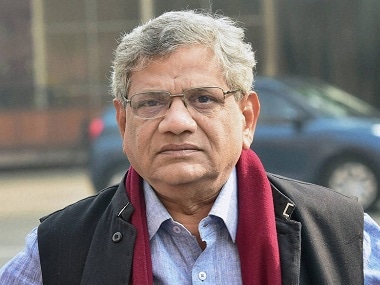After an unprecedented divide on whether or not to ally with the Congress, the CPM all-India meet chose to embrace a middle path. Such a consensus between the official and minority positions within the party is appreciative of divergent state-specific political realities. The party all-India conference chose a middle path by deciding to amend the official draft on the issue by omitting the crucial phrase "no understanding" with the Congress.
Earlier, the official draft presented at the party congress had said the party should unite secular democratic forces "without having an understanding or electoral alliance with the Congress party". But the amended document, that was finally adopted at the party all-India meet, stated that the party can unite secular democratic forces "without having a political alliance with the Congress party", thus keeping the doors open.
There cannot be any meaningful unity between anti-BJP forces without the presence of the Congress.
This is because the Grand Old Party remains the principal pan-Indian force to resist the Hindutva onslaught of the BJP parivar. Thus, the official draft foreclosing the option of any understanding with the Congress, if adopted, would have been an obstacle for the party's efforts to mobilise all likeminded forces against the BJP's alleged policies of communalism that the CPM considers the major challenge facing the nation along with policies of neo-liberalism. The party sees no difference between the BJP, Congress or regional parties for that matter when it comes to pursuing neo-liberal economic policies.
Thus, the consensus achieved at the end of the party congress has three dimensions:

File image of CPM leader Sitaram Yechury. News18
First, it still endorses the official draft position that there should not be any political alliance with Congress. However, instead of totally foreclosing any option of joining forces with Congress and other secular parties in fighting the BJP, the party final document specifies the areas of possible cooperation with all secular parties, which can include even Congress.
Thus, the second dimension is that, as Sitaram Yechury, said, "The CPM will not have a political alliance with Congress but an 'understanding' inside and outside Parliament to stop the forces of communalism".
Here, there is scope for interpretation on the nature and extent of 'understanding' the CPM will have with the Congress to resist the BJP juggernaut. This is the third dimension of the political-tactical line of the party adopted at the Hyderabad meet. The CPM central committee has to take a call as and when the situation arises.
Any political alliance with Congress can prove to be costly for the CPM in its only remaining bastion, Kerala. This is precisely why the party has to reiterate its position to not to have any political alliance with the Congress. The CPM wishes to take on both the BJP and Congress on its own wherever it can. But, such a situation is shrinking with the party losing West Bengal and Tripura. Thus, the political situation remains complex for the CPM.
Therefore, as Yechury said, the party will chalk out its "electoral-tactical line" on the basis of state-based ground realities. For instance, the party appealed to Karnataka voters to vote for any party that can defeat the BJP in the constituencies where the party is not contesting. This can obviously mean voting for the Congress too. The difference is if the party has a political alliance with the Congress, it would have voted for the party even where the JD(S) has chances of defeating the BJP, a senior leader of the party tells Firstpost.
The CPM, in an editorial written in the party organ People's Democracy, much before the all India conference in Hyderabad clarified its electoral tactics in the run upto 2019. The editorial states, "The Uttar Pradesh by-election provides important lessons for the future in terms of election tactics to defeat the BJP... the effective way to take on the BJP in the Lok Sabha election is not by forging an all-India alliance or front of all Opposition parties... So, the most effective electoral tactics to defeat the BJP in the Lok Sabha election will be to ensure the pooling of anti-BJP votes statewise... electoral tactics can be worked out which will help to maximise the pooling of the anti-BJP votes... If the major non-BJP parties unite, then the smaller parties and forces can extend support to them."
Prime Minister Narendra Modi likened the BJP 's victory in Tripura to its historic win in Uttar Pradesh. Tripura does not matter in the BJP's scheme of things for 2019. Yet, the saffron party accorded such an importance to election in a tiny North East state as the party considers the CPM its ideological foe. The CPM too considers BJP its principal political and ideological adversary.
The party's political tactical line adopted at the Hyderabad Congress will empower the party to spare no effort to defeat the BJP without compromising on its own political and electoral interests.
Meanwhile, the CPM expresses no aversion to ally with regional parties. But, the party feels it must be state-specific and programme-specific. This is the reason the CPM was not so enthused at the non-BJP, non-Congress front mooted by Telangana chief minister K Chandrasekhar Rao.
Speaking to Firstpost, CPM politburo member BV Raghavulu said that the party in its 22nd congress successfully evolved a united political-tactical line laying to rest alarmist expectations and hostile speculations. Although the CPM was compelled to take a middle path, the challenge lies in implementation of its political-tactical line on the ground. The possibilities for the party's growth depend largely on translating this theoretical understanding arrived at its Hyderabad congress into practice.
Updated Date: Apr 23, 2018 11:38 AM



